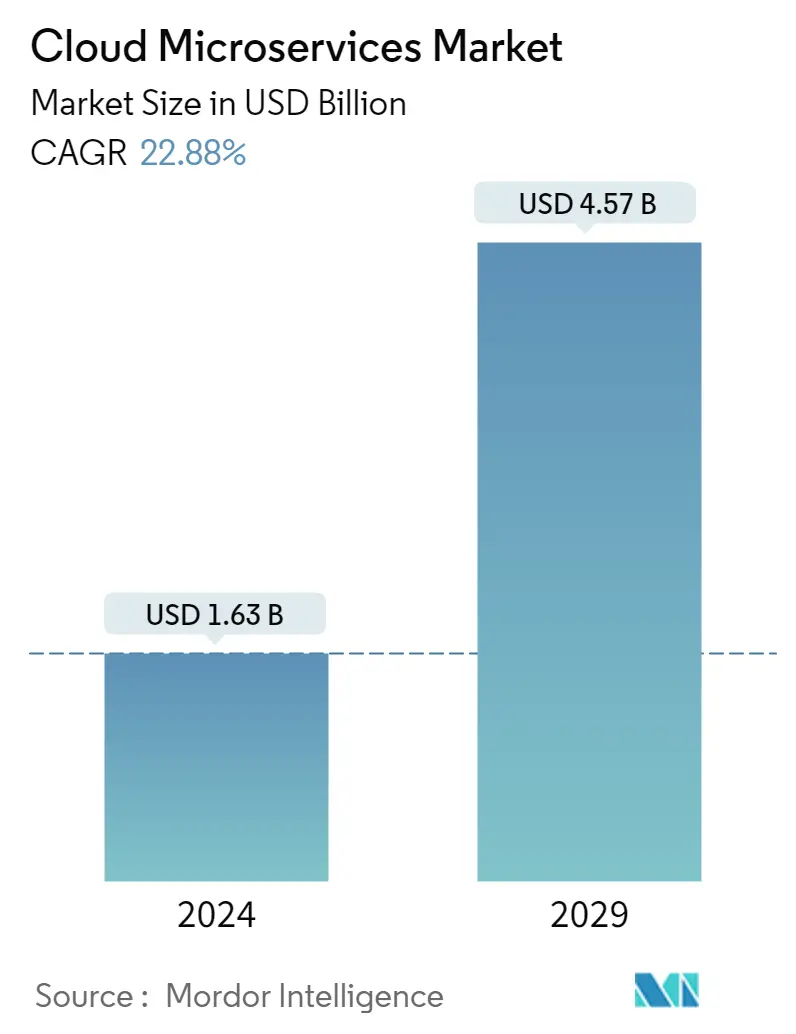| Study Period | 2021 - 2029 |
| Market Size (2024) | USD 1.63 Billion |
| Market Size (2029) | USD 4.57 Billion |
| CAGR (2024 - 2029) | 22.88 % |
| Fastest Growing Market | Asia Pacific |
| Largest Market | North America |
| Market Concentration | Low |
Major Players*Disclaimer: Major Players sorted in no particular order |
Cloud Microservices Market Analysis
The Cloud Microservices Market size is estimated at USD 1.63 billion in 2024, and is expected to reach USD 4.57 billion by 2029, growing at a CAGR of 22.88% during the forecast period (2024-2029).
As Kubernetes' adoption grows, companies are expected to start realizing that it is not enough to adopt it. They will also likely change all aspects of their processes, tools, and architecture. Kubernetes is likely to be a big push for profound company-wide changes. It provides an excellent way to manage containers and makes microservices architectures practical at an enterprise scale.
- Owing to the COVID-19 outbreak, the global demand for the cloud increased. Due to this, the cloud microservices were severely influenced until last year's end. The need for cloud services is growing due to a lack of workforce and remote monitoring requirements.
- The microservices architecture proliferation is driving the market, as it encourages breaking the application into smaller components. It becomes easy to apply changes. Deploying such components does not end up impacting a large part of the codebase. It is standard for such an architectural style to be adopted for cloud-native applications using lightweight container deployment. It is because of the large number of services, decentralized continuous delivery, and DevOps.
- Hybrid cloud adoption across various end-user industries is driving the market, as many enterprises are currently in different stages of cloud adoption. The hybrid cloud gives them maximum flexibility to explore new products and business models. As IT's role grew, the load on the data center was evolving. Investing money in upgrading computing or storage is costly, but hybrid cloud applications are cost-effective and drive the market.
- The growing cloud technology adoption across industries such as BFSI, IT, retail, and various others is augmenting the cloud microservices market growth. It is a significant part of an overall cloud management strategy, enabling IT administrators to review the cloud-based resources' operational status. For instance, United Arab Emirates-based Mashreq Bank adopted an advanced digital operating model, utilized microservices architecture, and leveraged real-time data for analytics.
- Security and compliance issues are restraining the market from witnessing growth. The container can create more software development environments, but it leads to new security risks that affect compliance. Cyber attackers can benefit from vulnerabilities inside the permission settings of cloud architecture to reach sensitive data services.
Cloud Microservices Industry Segmentation
Cloud microservices is an independent application, a distinctive method of developing software systems that focus on building single-function modules through the cloud. The scope of the study is currently focused on the regions, such as North America, Europe, and Asia-Pacific, among others. The study also tracks the key market parameters, underlying growth influencers, and major vendors operating in the market. The study further analyzes the COVID-19 impact on the demand-side market dynamics and the ecosystem on a near and short-term basis. The Cloud Microservices Market is segmented by deployment mode (platforms, services), enterprise size (small and medium enterprises, large enterprises), end-user industry (BFSI, retail, e-commerce, manufacturing, telecommunications, IT and ITes, healthcare, and other end-user industries), and geography (North America, Europe, Asia Pacific, Latin America, and Middle East & Africa).
The market sizes and forecasts are in terms of value (USD million) for all the above segments.
| Platforms |
| Service |
| Small and Medium Enterprises |
| Large Enterprises |
| BFSI |
| Retail |
| E-commerce |
| Manufacturing |
| Telecommunications |
| IT and ITes |
| Healthcare |
| Other End-user Industries |
| North America |
| Europe |
| Asia Pacific |
| Latin America |
| Middle East and Africa |
Cloud Microservices Market Size Summary
The cloud microservices market is poised for significant growth, driven by the increasing adoption of Kubernetes and the proliferation of microservices architecture. This architectural style, which breaks applications into smaller, manageable components, is becoming standard for cloud-native applications due to its ease of implementing changes without impacting the entire codebase. The market is further bolstered by the hybrid cloud model, offering enterprises flexibility in exploring new products and business models while managing costs effectively. Industries such as BFSI, IT, and retail are increasingly adopting cloud technologies, with companies like Mashreq Bank leveraging microservices for advanced digital operations. However, security and compliance challenges pose potential restraints, as the containerization process introduces new vulnerabilities.
The manufacturing sector is witnessing a surge in demand for microservices cloud solutions, driven by the dissolution of traditional automation structures and a shift towards service-oriented IT. Companies are leveraging platforms like AWS for cost-effective, on-demand capacity in smart manufacturing initiatives. The integration of IoT and microservices, as seen with ThyssenKrupp's predictive maintenance solutions, highlights the sector's move towards IT-supported capabilities. North America, in particular, is experiencing high market share due to advanced technology adoption in sectors like finance and e-commerce. Major players such as Amazon Web Services, Microsoft, and IBM are expanding their market presence through strategic partnerships and acquisitions, further fueling the market's growth trajectory.
Cloud Microservices Market Size - Table of Contents
1. MARKET DYNAMICS
- 1.1 Market Overview
- 1.2 Introduction to Market Drivers and Restraints
-
1.3 Market Drivers
- 1.3.1 Proliferation of the Microservices Architecture
- 1.3.2 Adoption of Hybrid Cloud Across Various End-user Industries
-
1.4 Market Restraints
- 1.4.1 Security and Compliance
- 1.5 Industry Value Chain Analysis
-
1.6 Industry Attractiveness - Porter's Five Forces Analysis
- 1.6.1 Bargaining Power of Suppliers
- 1.6.2 Bargaining Power of Buyers/Consumers
- 1.6.3 Threat of New Entrants
- 1.6.4 Threat of Substitute Products
- 1.6.5 Intensity of Competitive Rivalry
2. MARKET SEGMENTATION
-
2.1 By Deployment Mode
- 2.1.1 Platforms
- 2.1.2 Service
-
2.2 By Enterprise Size
- 2.2.1 Small and Medium Enterprises
- 2.2.2 Large Enterprises
-
2.3 By End-user Industry
- 2.3.1 BFSI
- 2.3.2 Retail
- 2.3.3 E-commerce
- 2.3.4 Manufacturing
- 2.3.5 Telecommunications
- 2.3.6 IT and ITes
- 2.3.7 Healthcare
- 2.3.8 Other End-user Industries
-
2.4 By Geography
- 2.4.1 North America
- 2.4.2 Europe
- 2.4.3 Asia Pacific
- 2.4.4 Latin America
- 2.4.5 Middle East and Africa
Cloud Microservices Market Research FAQs
How big is the Cloud Microservices Market?
The Cloud Microservices Market size is expected to reach USD 2.00 billion in 2025 and grow at a CAGR of 22.88% to reach USD 5.61 billion by 2030.
What is the current Cloud Microservices Market size?
In 2025, the Cloud Microservices Market size is expected to reach USD 2.00 billion.




